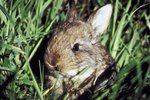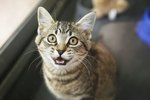Siamese cats originated in Thailand, formerly called Siam. They arrived in England in 1884 as gifts to a British general and eventually made their way to the Americas. They are much like every other cat in that they love to sleep, watch birds and play with their owners. The main difference is in their long life of 15 to 20 years and their appearance. Siamese cats are born all white and mature into tan colored cats with dark "points," which refer to the coloring of their ears, face, paws, legs and tail. Seal point means these features are dark brown, while blue point means they are of a blue-gray appearance. Much about the Siamese cat can affect the habitat it should live in.
Self-Grooming

While many Siamese cats are classified as short-haired, it is still important to brush them once or twice weekly, as stated by the Cozy Cat Furniture website. As this may seem too often for some, a self-brushing toy, such as the Cat Hair Magnet found in many pet stores, placed in an area the cat frequents, will allow it to literally brush itself. This is no substitute for a good deep brushing, but it will capture the loose fur on the cat's body, leading to fewer hairballs and a smoother coat.
Genetic Problems

Siamese cats are lucky in that their genetic issues are generally more easily dealt with than those of some other purebreds, seldom necessitating habitat modification. The owner should be aware that these cats can sometimes be cross-eyed or have kinked tails, though these defects should not affect health or behavior, as noted on the Travels with Tigger website. This does not mean that Siamese cats can go without checkups as they should still have access to veterinary care.
Bad Habits

High places are where Siamese cats love to go, be it the top of a bookshelf or a refrigerator. It's good to keep breakable objects off these areas and even provide an alternative observation perch for the cat. Another habit Siamese cats are known for is mock feeding. This is when the cat kneads and suckles a soft material, like a sweater, similarly to how it would when feeding from its mother. Provide a security blanket in a soft, comfortable area specifically for this purpose.
Habitat for Private Purrsonalities

Siamese cats are much like humans in that they prefer to do their business in private. Placing an enclosed litter box in a quiet, low-traffic area of their habitat gives them that privacy. Travels with Tigger also indicates that Siamese cats are usually tolerant of children but will retreat to a quiet, private area when they have had enough poking and prodding.
Adventures in Store

With exploratory personalities, Siamese cats enjoy checking out new areas. For owners who don't mind taking these indoor cats outside for a little while, it's a good idea to supervise them in a fenced, outdoor area. Otherwise, keep one or two rooms in their habitat closed off to them except for special occasions. Change around the elements of these rooms from time to time and add different objects for the cat to check out.
Habitat for Play

Siamese cats have moderate to high energy levels, requiring a high-protein diet and lots of play time. While it's best for a cat to have another cat companion, there should still be plenty of toys in its habitat. A cat can play with certain toys by itself, such as squeaking toys and rolling balls, while other toys allow the owner to interact with the cat, like shoestrings or a toy fishing wand. Supervise play with any string narrow enough to become tangled around the tongue.
References
Photo Credits
-
Jupiterimages/Photos.com/Getty Images
Writer Bio
Pam Smith has been writing since 2005. In addition to her work for Demand Media, her articles have been published online at CBS Local. She also wrote for the Pennsylvania Center for the Book's Literary Map while earning a Bachelor of Arts degree in English at the Pennsylvania State University. She is currently an editorial assistant for Circulation Research.




